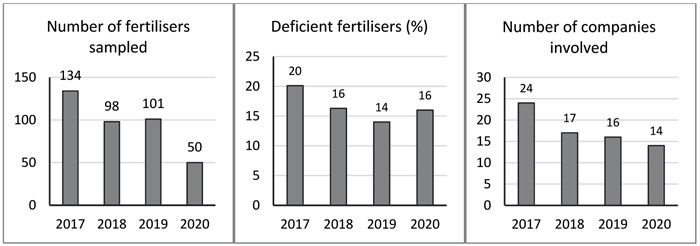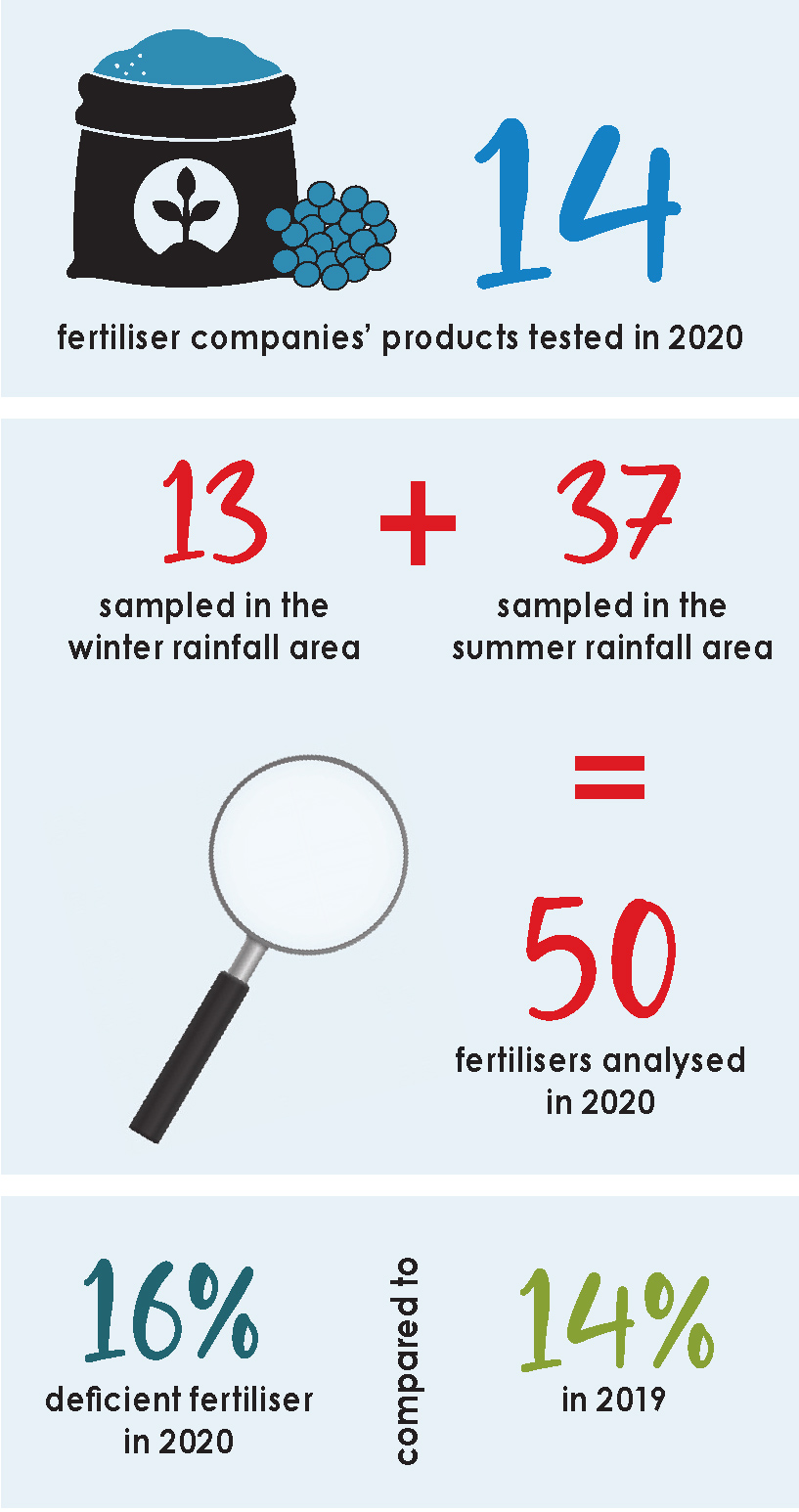
 Dr André Nel,
Dr André Nel, independent
agronomist
 William Deale, independent
William Deale, independentagronomist
In 2017 a memorandum of understanding for the funding and management of the fertiliser and lime quality monitoring project was entered into by and between the Department of Agriculture, Forestry and Fisheries (now Department of Agriculture, Land Reform and Rural Development), Fertasa (Fertilizer Association of Southern Africa), Grain SA and the Sasol Agricultural Trust.
This project continued in 2020, with the aim to establish whether liming material and fertiliser quality are maintained according to the regulations of the Fertiliser Act (Act No. 36 of 1947) through random sampling of at least 140 fertilisers and 10 lime sources.
Due to COVID-19 restrictions, officials from the provincial departments sampled only 50 fertilisers from 14 fertiliser companies. 13 fertilisers were sampled in the winter rainfall area and 37 in the summer rainfall area, almost all of it on farms. Four limes and one gypsum were sampled in the winter rainfall area and three limes in the summer rainfall area. Fertiliser samples were initially analysed by Omnia and the results evaluated according to the regulations stipulated in the Act. Ten fertilisers were non-compliant and were re-analysed for a second and some for a third time by independent laboratories to reach a conclusion.
Of the 50 fertilisers, 16% were deficient in one nutrient. All of the 50 nitrogen-containing fertilisers were compliant. 39 fertilisers contained phosphorus, of which one (3%) was deficient. One (3%) of the 33 potassium-containing fertilisers was deficient. 40 fertilisers contained sulphur and 17 calcium – none of which were deficient.
All of the seven limes sampled failed the 1,7 mm-sieve test and four also failed the 0,25 mm-sieve test, but complied with the calcium, magnesium and CCE requirements. One gypsum was sampled and complied with the physical and chemical requirements.
Results: fertilisers
Summarising statistics on the number of fertilisers sampled and analysed, samples with deficiencies and the number of companies involved in 2020 are shown in Table 1. As indicated, 26% of the total number of fertilisers was sampled in the winter rainfall area and 74% in the summer rainfall area. One fertiliser (8%) from the winter rainfall area had a deficiency in only one nutrient. Seven fertilisers (19%) were deficient in the summer rainfall area, each in only one nutrient.
 Interesting trends from 2017 to 2020
Interesting trends from 2017 to 2020
Some relevant statistics for the various fertilisers sampled from 2017 to 2020 are graphically displayed in Figure 1. It should be kept in mind that the number of fertilisers sampled and number of companies involved declined over time and that the same companies or number of samples from each company varied over time. Thus, assuming that the four investigations (each on its own) are a true reflection of the fertiliser quality of each year, the following can be stated:
- The percentage of fertilisers with deficiencies declined from 2017 to 2018 and then varied between 14% and 16% from 2018 to 2020.
- For individual nutrients (nitrogen, sulphur and boron) the percentage deficient fertilisers declined, while fertilisers deficient in phosphorus, potassium, calcium and magnesium varied with no particular trend. Total nutrient (nitrogen + phosphorus + potassium) deficiencies also declined.
- Zinc-deficient fertilisers showed a large increase in 2020 compared to previous years.
- From 2017 to 2019, fertilisers with more than one deficient nutrient were found. In 2020 all deficient fertilisers had only one deficient nutrient.

 Conclusion
Conclusion
Considering all parameters evaluated in 2020, excess amounts of nutrients were present in fertilisers as the mean measured content was from 1% to 5% higher than the mean registered content for total nutrients and the individual macronutrients nitrogen, phosphorus, potassium and sulphur. This implies that these products fulfilled quality standards – and even exceeded it. 16% of fertilisers, however, was deficient with 12% alone due to inadequate amounts of zinc.
The number of fertilisers sampled and companies involved declined from the 2017 investigation to the 2020 investigation. Over this period the percentage deficient fertiliser initially declined and has been fluctuating between 14% and 16% for the past three years.
None of the liming materials evaluated in 2020 complied with the particle size quality standards, but all exceeded the minimum chemical requirements. The single gypsum sampled met all requirements.



















